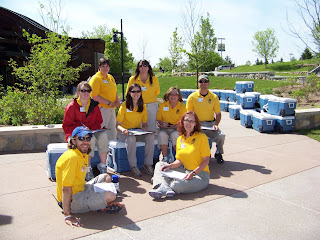
Catching Up with Kalijon
As many of you know, our female orangutan “T.K.” gave birth to a baby around 9 months ago. Although keeper staff worked hard to train T.K. to perform various maternal behaviors, providing her with the skills necessary to raise her own infant, T.K. did not adequately care for her baby.
Zoo staff set out to raise the infant female, named “Kalijon”, until she became old enough to introduce to a surrogate orangutan mother. Thus began four and a half long months of caring for Kalijon. Staff and volunteers worked with Kalijon 24/7 taking turns staying at the orangutan building night and day so she would grow up completely familiar with the sights, sounds, and smells of other orangutans.
When Kali was old enough, she was introduced to our female “Jill” who is an experienced mother and was already trained to bring an infant to the stall mesh so keepers could provide bottles of milk. To make a long story short-surrogate mom and baby are now inseparable!
I have to say, no one would ever imagine that these to are not biological mother and daughter! They stay in close contact with each other the majority of the time. However, as Jill is a very experienced mom, she is willing to allow Kalijon a lot of freedom to climb around and play like she loves to do. Kali has a mouth full of bright white baby teeth now so her grins are extra special to behold. Those choppers are also allowing her to eat lots of produce and primate chow biscuits, so it won’t be too many more months before she is done with milk all together. Hard to believe!
Her bushy red hair just keeps getting longer and crazier. Her arms are still very small, so she can reach out through the mesh to examine her keepers. She especially likes to pull up the cuffs of our shirt sleeves to feel around inside them. And if you are wearing glasses or a hat, she will try to snatch them! If Jill comes over and tries to stick her fingers out towards us, Kali will sometimes tug Jill’s hands back from the mesh as if she doesn’t want to share our attention with her mom.
If you haven’t yet been out to see Jill and Kalijon together, you REALLY should. They can be seen in the dayroom (their indoor exhibit) on Tuesdays and weekends until 12:30. Jill is very good about bringing Kalijon to the viewing windows where all can see what a good mom she is to her beautiful adopted daughter. Our hard work combined with Jill’s mothering skills will give Kalijon the best possible chance of being a successful mom herself someday!
Heidi, Animal Supervisor











